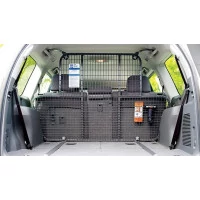Oxygen Sensor
Your vehicle is equipped with a catalytic converter, which reduces the amount of harmful byproducts of burning fuel. Its proper performance is crucial for your vehicle’s operation, which is why it is kept under control by your engine control unit. It relies on a special type of sensors, known as oxygen sensors, to analyze catalytic converter operation.

As its name indicates, an oxygen sensor calculates the amount of oxygen in the exhaust stream and converts these data into signals sent to the engine control unit. Based on the signals received, your engine control module determines the amount of oxygen in the exhaust gases and their temperature, and makes different system adjustments. It can also turn on the check engine light if the sensor provides incorrect readings or fails to send signals at all.
Your oxygen sensors are just a few of the vehicle’s sensors, providing the engine control module with accurate information about different aspects of engine operation. The computer compares data received from different sources to calculate the amount of fuel that needs to be forced into the combustion chamber or to set ignition timing. But still, every sensor is crucial for smooth and efficient engine operation, so its failure may cause a number of engine related problems.
While there are vehicles with four or even more oxygen sensors, most likely, your vehicle is equipped with two oxygen sensors: one before the catalytic converter, and the other one just after it. The first one is called an upstream sensor, while the other one is known as a downstream sensor.
What is an upstream oxygen sensor?
It is an oxygen sensor that is located as close to the engine as possible. It is used to calculate the amount of oxygen in exhaust gases that leave the engine to determine whether the engine is running lean or rich. If the sensor says there is too much oxygen in the gases, this causes the engine control module to add more fuel into the combustion chamber. And vice versa, if the engine is running too rich, there will be too little oxygen in the exhaust gases, so the computer will command to force less fuel into the cylinders. The signals from the sensor constantly fluctuate, allowing the computer to maintain the perfect balance of fuel and air in the engine.
What is a downstream oxygen sensor?
Unlike the upstream sensor, the downstream sensor is located after the cat, and serves a completely different purpose. It is used to monitor the operation of the catalytic converter to make sure no harmful pollutants are released into the outside air. If both catalytic converter and sensor perform properly, the sensor should supply steady voltage.
Since upstream and downstream sensors perform different functions, they are not interchangeable. Besides, many modern cars come equipped with a wide-band upstream sensor, which is smarter and more efficient compared to traditional upstream sensors.
Signs of a bad oxygen sensor
Your check engine light is on
Both sensors continuously send signals to the engine control module. If one of them stops supplying voltage to the computer or sends incorrect data, the module will turn on the check engine light and store a trouble code. This can be a sign of a failed sensor or a problem with the engine or catalytic converter.
Lack of engine performance
A faulty upstream oxygen sensor will supply incorrect data to the engine control unit. Since the latter relies on these data to prepare an air/fuel mixture, your engine can run inefficiently, providing poor performance and acceleration.
Increased fuel consumption
If a bad oxygen sensor causes the fuel system to supply too much fuel into the engine, your fuel consumption will noticeably increase.
Oxygen sensor troubleshooting and replacement
An oxygen sensor can fail due to a couple of reasons. This can happen because of a manufacturing defect or if the sensor is contaminated with fluid or engine oil. In this case the sensor should be either replaced or cleaned with a sensor-safe throttle body cleaner. We do not recommend you to use any type of carburetor cleaners as they may damage the sensor. Before replacing or reinstalling the sensor, you need to be sure the leak that caused the problem is fixed.
We recommend you to leave both diagnosis and replacing procedures to a professional. They often involve OBD-II trouble code scanners and lifting the vehicle to remove and install a sensor. Besides, you may need a special oxygen sensor socket to remove a sensor safely.




